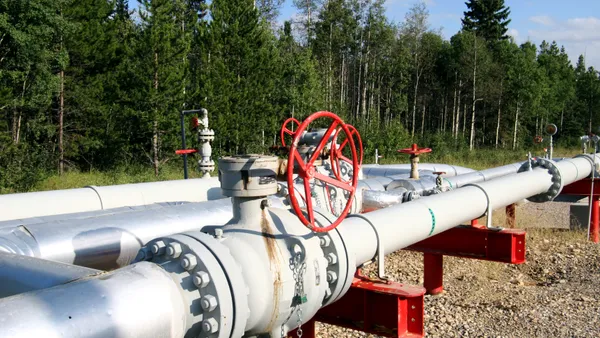Dive Brief:
- Pacific Gas & Electric (PG&E) told California regulators last week that splitting the utility into separate electric and gas companies could create some safety improvements, but would also be a costly endeavor that would likely raise customer rates.
- The California Public Utilities Commission (CPUC) is considering a wide range of steps to ensure PG&E operates safely, including possible new corporate structures and governance. The CPUC launched the investigation in December, as it considers the possible role PG&E's electric system played in sparking some of California's wildfires.
- Reports surfaced last summer that PG&E was considering splitting the company apart, in order to financially protect some units from wildfire liabilities. The utility has since filed for bankruptcy and asked a court to prevent federal regulators from enforcing the terms of some power purchase agreements (PPA).
Dive Insight:
After a two-week extension requested by utility reform advocates, initial comments in the PG&E proceeding sketched out the concerns of various parties and shed some light into the feasibility of splitting apart one of the largest combined electric and gas utilities in the country.
PG&E told regulators in its comments that separation of its gas and electric operations "appears feasible from a technical and operational perspective."
The gas and electric systems are "functionally independent from one another" and each has its own control center, PG&E said. "The separation of PG&E’s gas operations from its electric operations has the potential to reduce the total risks managed by a single entity. This could increase operational focus by each entity and improve the development of each entity’s safety management system."
And the utility gave its "preliminary opinion" that if the companies were separated, each would probably "be of sufficient scale to continue to respond to emergencies and would have sufficient expertise in the compliance and risk management functions."
But while there are potential benefits, PG&E also warned regulators that splitting the company in two would probably increase rates and create incremental costs associated with the duplication of services that are currently shared: technology infrastructure, service centers, equipment storage, and billing and customer support.
There would also be "ongoing dis-synergies and dis-economies of scope," PG&E said, associated with the need for more employees and the duplication of corporate services across separated entities.
"While separation of PG&E’s gas and electric operations would present a number of challenges, PG&E is prepared to explore this possibility with stakeholders and the commission," the utility said.
Other parties weigh in on separation
The city and county of San Francisco is blunt in its assessment of PG&E: "History demonstrates that it cannot safely manage its assets."
The utility serves 16 million customers in a 70,000 square-mile area that includes three of California's largest cities.
"Managing these complex gas and electric businesses would be a challenging assignment for any company," the city and county wrote. "Other IOUs in California are either serving a much smaller region or are providing a single service. Dividing PG&E into smaller entities could allow each to perform more effectively."
The separation could take several forms, San Francisco lawyers wrote: geographic, functional or by service. But "with the enhanced threat of wildfires, PG&E’s ability to carefully manage even remote regions is essential."
Somewhat surprisingly, a major critic of the utility declined to weigh in on the possible changes to PG&E's corporate structure. The Utility Reform Network (TURN), the group that asked for and received the comment time extension, said it "may address this issue in reply comments."
"Being sticklers for details, we don't feel comfortable taking a position on the idea generally, i.e., break up by function or by geography, public vs. private," TURN communications head Mindy Spatt told Utility Dive in an email.
But TURN also said the CPUC should "prepare itself for a more invasive approach to regulation, as long as PG&E continues to provide electric and gas service to Californians." And the group said regulators need to acknowledge that wildfire liability costs "could affect any potential alternative electric service provider, as long as utilities can be held strictly liable for property damage caused by their facilities irrespective of negligence."
The American Public Power Association (APPA) told regulators it took "no position regarding what specific actions, if any, the commission should pursue concerning PG&E’s governance, structure, and operations." Instead, the group went on to highlight the advantages of publicly owned utilities.
Regulators had asked parties to weigh in on whether PG&E should “be reconstituted as a publicly owned utility or utilities.” APPA pointed to low rates traditionally offered by public utilities.
"As not-for-profit entities, publicly owned utilities have no incentive to sustain high prices to benefit shareholders," the group said. "Publicly owned utilities determine investments in facilities based on the benefit to safety, reliability, efficiency, and customer cost. As a result, publicly owned utilities do not have an economic bias toward high-cost, capital-intensive technologies or system 'gold plating' to increase rate base."
NextEra Energy Resources filed comments aimed at protecting approximately 945 MW of capacity in PPAs signed with PG&E. The wholesale power supplier told California regulators that consideration of any "transformational changes to PG&E should preserve commercial commitments that the Commission has already approved in the form of PG&E’s existing long-term PPAs with owners of renewable power generating facilities that were built and financed in reliance on those PPAs."
NextEra also told regulators that potential structural changes to PG&E should ensure that the resulting framework "encourages and facilitates continued development of new renewable and zero carbon generating resources in California."














